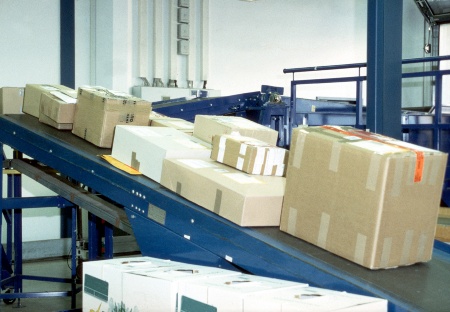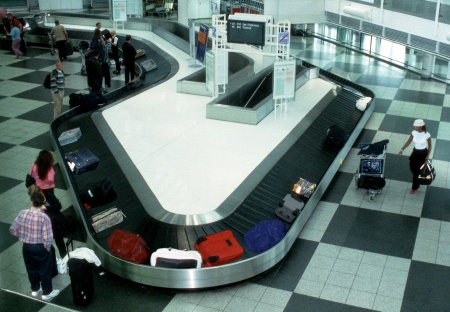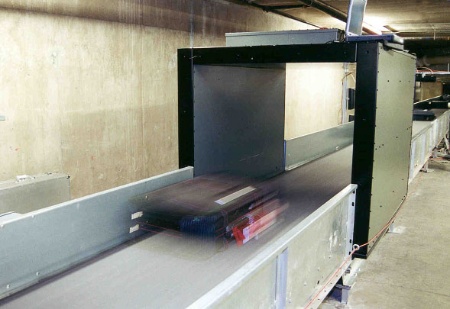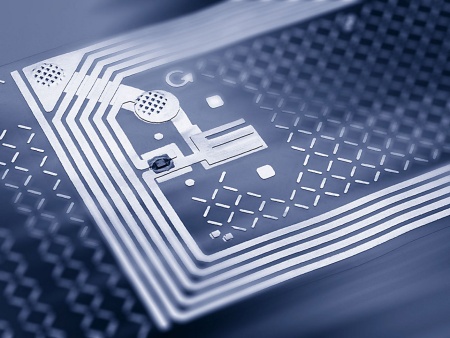Infineon Takes Chip Labels to a Higher Plane - 25 Times Faster than Current Products
Munich, Germany December 2, 2003 German semiconductor manufacturer Infineon Technologies (FSE/NYSE: IFX) wants to revolutionize electronic labels for industrial and logistics applications with innovative RFID technology. The newly unveiled chips can be read and written at lightning speed by wireless. They are suitable for contactless electronic identification of fast-moving objects. The focus is on applications for baggage handling at airports, textile industry logistics, mass merchandising and dispatch, conveyor belt production, and courier and postal services. Infineon co-developed the chip with Australian company Magellan Technology on the basis of Magellans PJM technology. In line with its Agenda 5-to-1 strategy, Infineon intends to do more than just produce the chips in future. It also wants to develop and plan entire electronic identification systems including the infrastructure and software for the industry.
The chip achieves roughly 25 times the read and write speeds of existing RFID (Radio Frequency Identification) technologies operating at the approved European radio frequency 13.56 megahertz. The technology, which is optimized for logistics applications, is capable of reliably identifying, reading and writing up to 500 electronic labels in less than a second. The new chips cope even with conveyor belt speeds of approx. 15 kilometers per hour (4 meters per second). With existing RFID technology, identification performance tops out at 30 electronic labels per second, equivalent to a speed of half a meter per second.
The new RFID chips operate with PJM (Phase Jitter Modulation) technology in order to evaluate the radio signals of the identification labels. Constant switching between eight different radio channels increases read speeds and ensures positive identification even in mass throughput applications.
Contactless identification rates as a key technology in optimizing industrial processes in manufacturing and logistics. For this purpose, individual workpieces in a production or sales process are fitted with an RFID chip as though with a label. All the important information is stored on this chip. Once activated by a reader, the chips are read in a contactless manner by electro-magnetic waves in order to control further production steps, but also to verify the origin and processing status of individual parts and products or, for example, to check a packing unit for completeness.
Electronic identification plays a significant economic role in light of the increasing trend in industry to produce highly individualized products and at the same time achieve capital expenditure savings through efficient inventory management and intelligent logistics. Industrial applications in logistics and production are therefore regarded as the strongest growth sector in the RIFD chips market. According to figures published by market researchers for Allied Biz Intelligence, the chips are expected to account for more than 50 percent of the total RFID transponder market with global sales of 1.1 billion euros by as early as 2007.
Until now, in order to be read electronic labels had to be held, preferably one at a time, for a few tenths of seconds in front of a reader, like the labels on consumer goods in front of a barcode scanner. This disrupts the workflow in industrial environments. The PJM chips will be ready to ship in volume early in 2004. It will be available in two versions, both of which allow reliable identification in different situations: as a PJM ItemTag® for fast-moving separate items on, say, conveyor belts or in parcel sorting systems, and as a PJM StackTag®, by means of which hundreds of labels can be identified simultaneously. The signals are processed in the reader even if the labels are unsorted or packed tightly together. Previously, this was considered impossible for physical reasons.
Infineon is cooperating closely with Magellan Technology on the design, planning and introduction of PJM technology in logistics applications.
For technical information on Magellan Technologys PJM technology please go to www.magtech.com.au
The chip achieves roughly 25 times the read and write speeds of existing RFID (Radio Frequency Identification) technologies operating at the approved European radio frequency 13.56 megahertz. The technology, which is optimized for logistics applications, is capable of reliably identifying, reading and writing up to 500 electronic labels in less than a second. The new chips cope even with conveyor belt speeds of approx. 15 kilometers per hour (4 meters per second). With existing RFID technology, identification performance tops out at 30 electronic labels per second, equivalent to a speed of half a meter per second.
The new RFID chips operate with PJM (Phase Jitter Modulation) technology in order to evaluate the radio signals of the identification labels. Constant switching between eight different radio channels increases read speeds and ensures positive identification even in mass throughput applications.
Contactless identification rates as a key technology in optimizing industrial processes in manufacturing and logistics. For this purpose, individual workpieces in a production or sales process are fitted with an RFID chip as though with a label. All the important information is stored on this chip. Once activated by a reader, the chips are read in a contactless manner by electro-magnetic waves in order to control further production steps, but also to verify the origin and processing status of individual parts and products or, for example, to check a packing unit for completeness.
Electronic identification plays a significant economic role in light of the increasing trend in industry to produce highly individualized products and at the same time achieve capital expenditure savings through efficient inventory management and intelligent logistics. Industrial applications in logistics and production are therefore regarded as the strongest growth sector in the RIFD chips market. According to figures published by market researchers for Allied Biz Intelligence, the chips are expected to account for more than 50 percent of the total RFID transponder market with global sales of 1.1 billion euros by as early as 2007.
Until now, in order to be read electronic labels had to be held, preferably one at a time, for a few tenths of seconds in front of a reader, like the labels on consumer goods in front of a barcode scanner. This disrupts the workflow in industrial environments. The PJM chips will be ready to ship in volume early in 2004. It will be available in two versions, both of which allow reliable identification in different situations: as a PJM ItemTag® for fast-moving separate items on, say, conveyor belts or in parcel sorting systems, and as a PJM StackTag®, by means of which hundreds of labels can be identified simultaneously. The signals are processed in the reader even if the labels are unsorted or packed tightly together. Previously, this was considered impossible for physical reasons.
Infineon is cooperating closely with Magellan Technology on the design, planning and introduction of PJM technology in logistics applications.
For technical information on Magellan Technologys PJM technology please go to www.magtech.com.au
About Infineon
Infineon Technologies AG, Munich, Germany, offers semiconductor and system solutions for the automotive and industrial sectors, for applications in the wired communications markets, secure mobile solutions as well as memory products. With a global presence, Infineon operates in the US from San Jose, CA, in the Asia-Pacific region from Singapore and in Japan from Tokyo. In the fiscal year 2003 (ending September), the company achieved sales of Euro 6.15 billion with about 32,300 employees worldwide. Infineon is listed on the DAX index of the Frankfurt Stock Exchange and on the New York Stock Exchange (ticker symbol: IFX). Further information is available at www.infineon.com.
Infineon and the stylized Infineon Technologies design are trademarks and service marks of Infineon Technologies AG. Any other trademarks appearing herein are the property of their respective owners.
Video material can be downloaded from www.thenewsmarket.com.
Information Number
INFSMS200312.018
Press Photos
-
 Optimized for logistics applications, the "PJM ItemTag®" chips are used for fast-moving separate items on, say, conveyor belts or in parcel sorting system.Press Photo
Optimized for logistics applications, the "PJM ItemTag®" chips are used for fast-moving separate items on, say, conveyor belts or in parcel sorting system.Press PhotoJPG | 525 kb | 1535 x 1063 px
Press PhotoJPG | 11 kb | 160 x 111 px
-
 Baggage claim area at the airport.Press Photo
Baggage claim area at the airport.Press PhotoJPG | 559 kb | 1535 x 1063 px
Press PhotoJPG | 11 kb | 160 x 111 px
-
 Infineons PJM (Phase Jitter Modulation) chips are suitable for contactless electronic identification of fast-moving objects, such as baggage handling at airports. Here: baggage claim area. Photo: Magellan TechnologyPress Photo
Infineons PJM (Phase Jitter Modulation) chips are suitable for contactless electronic identification of fast-moving objects, such as baggage handling at airports. Here: baggage claim area. Photo: Magellan TechnologyPress PhotoJPG | 59 kb | 589 x 405 px
Press PhotoJPG | 7 kb | 160 x 110 px
-
 RFID tag with chip and antenna; size 7.5 cm x 4.5 cm.Press Photo
RFID tag with chip and antenna; size 7.5 cm x 4.5 cm.Press PhotoJPG | 275 kb | 1291 x 969 px
Press PhotoJPG | 11 kb | 160 x 120 px
